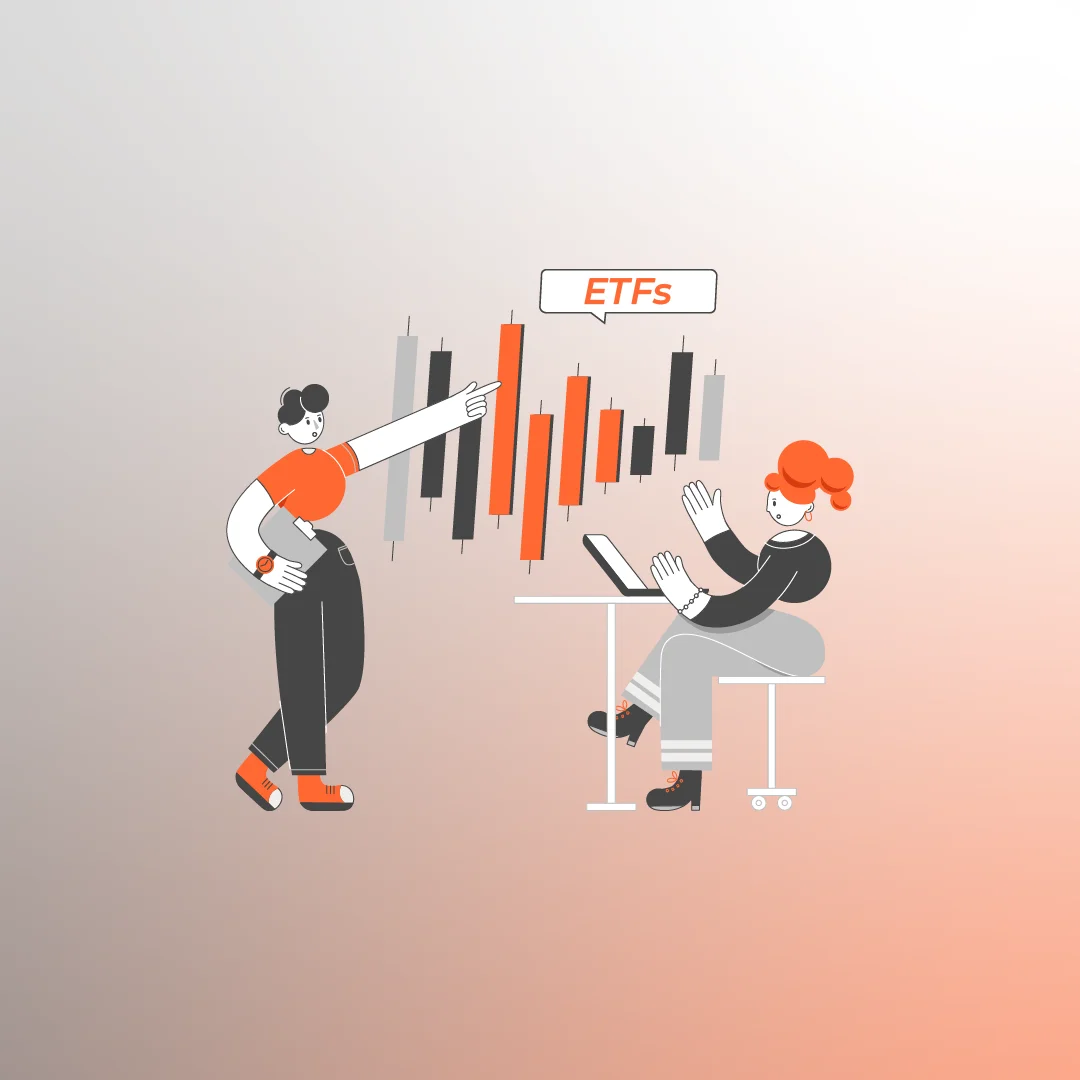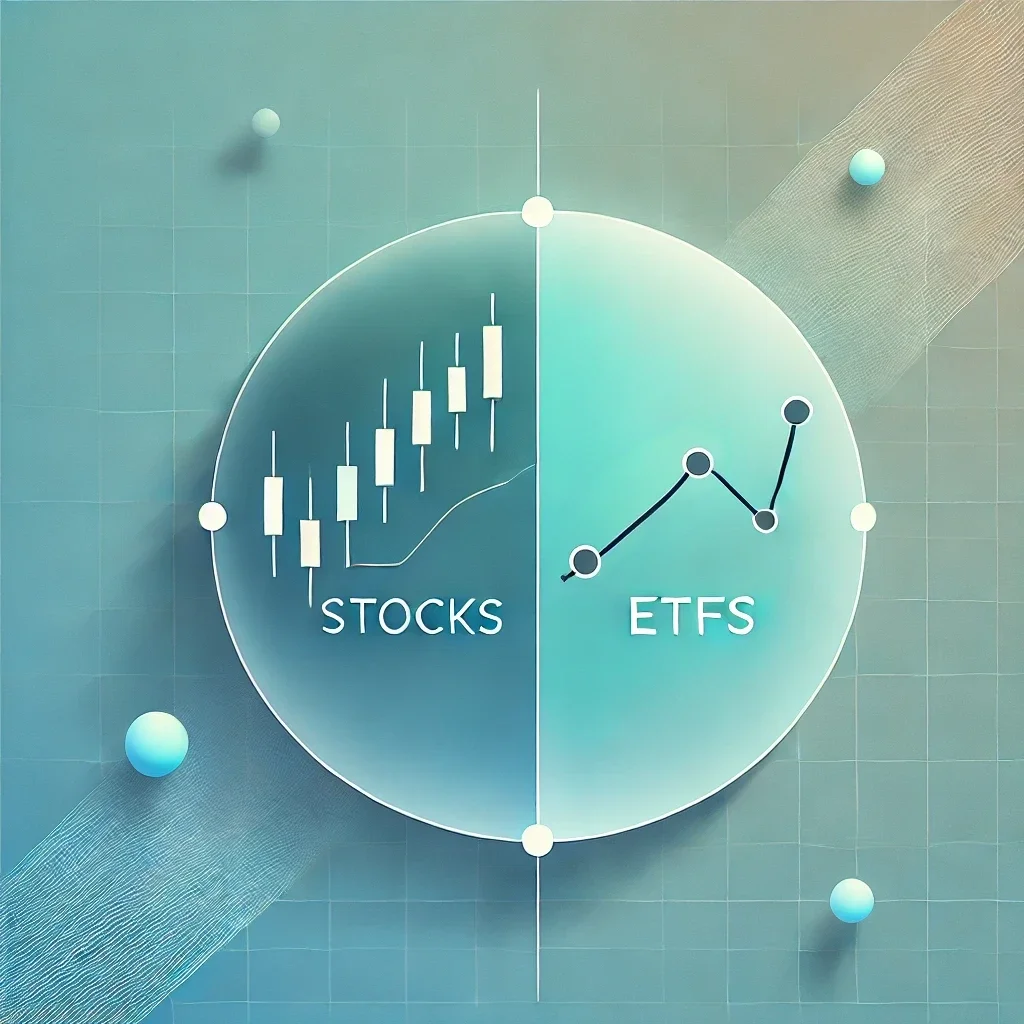
ETFs, or Exchange Traded Funds, have gained a lot of attention from both new and experienced investors in recent years. They have gone from being a niche product to a huge global market. Trillions of dollars are now invested in thousands of different ETFs.
They've become very common in retirement accounts, brokerage platforms, and financial news headlines. But what exactly are ETFs, and why do individuals and institutional investors like them so much? Let's get into it.
What Are Exchange Traded Funds (ETFs)?

An Exchange Traded Fund (ETF) is a type of investment fund that holds a basket of securities, such as stocks, bonds, commodities (e.g., gold bars), or a combination of these assets. ETFs are designed to track the performance of a specific index, sector, or asset class. For example, an S&P 500 ETF would hold a portfolio of stocks that mirrors the composition of the S&P 500 index.
They offer investors an easy and cost-effective way to gain exposure to a diversified portfolio of securities in a single transaction.
.webp)
ETFs are traded on stock exchanges, just like individual stocks, and their prices fluctuate throughout the trading day based on supply and demand. This is different from mutual funds, which are priced only once at the end of each trading day. Investors can buy and sell ETF shares through their brokerage accounts, making them highly accessible and liquid investment vehicles.
Why Are ETFs So Popular?
Exchange-traded funds (ETFs) have experienced tremendous growth in popularity among investors in recent years. As of the first quarter of 2024, ETFs represent 13% of equity and 2.8% of fixed-income assets in the U.S., compared to 10.3% of equities and 2% of fixed income in 2019.

(U.S. Listed ETF Market Size, Source: iShares)
Around $37.9 trillion worth of stocks, ETFs, and depository receipts changed hands in the U.S. equity market, and $10.6 trillion worth of ETFs traded in the first quarter of 2024. This growth can be attributed to several key factors that make ETFs an attractive investment option.
Lower Costs and Higher Returns
One of the primary reasons for ETFs' popularity is their cost-effectiveness. ETFs typically have lower expense ratios than actively managed mutual funds, as they are passively managed and aim to track an index rather than outperform it. This cost-efficiency can result in higher returns for investors over the long term.
Flexibility and Ease of Trading
Another factor contributing to the rise of ETFs is their ease of use and accessibility. ETFs trade on stock exchanges, just like individual stocks, and can be bought and sold throughout the trading day. This flexibility allows investors to quickly adjust their portfolios in response to market conditions or personal financial needs.
Exposure to Diverse Asset Classes
ETFs also offer investors a simple way to achieve diversification. A single ETF can expose a wide range of stocks, bonds, or other assets, reducing the risk of investing in individual securities. This diversification benefit is particularly valuable for investors who may not have the time, expertise, or resources to construct a well-diversified portfolio on their own.
Transparency in Holdings and Risks
The transparency of ETFs is another appealing feature for many investors. ETFs are required to disclose their holdings daily, allowing investors to know exactly what they own and the associated risks. This level of transparency can help investors make more informed decisions and avoid surprises.
Tax Efficiency
ETFs are generally more tax-efficient than mutual funds due to their unique structure and lower turnover. When a mutual fund investor redeems their shares, the fund may need to sell securities to raise cash, potentially triggering capital gains that are passed on to all shareholders.
In contrast, ETF shares are often exchanged between investors on the secondary market, minimizing the need for the fund to sell holdings and generate capital gains.
How Do ETFs Work?
As we discussed earlier, exchange-traded funds (ETFs) are designed to track the performance of a specific index, sector, or asset class. They achieve this by holding a basket of securities that closely mimics the composition of the underlying benchmark.
Here is a simple diagram that shows how ETFs (Exchange-Traded Funds) work:

Investors buy shares of the ETF.
ETFs pool the money from these investors.
The ETF uses this pooled money to buy a basket of assets such as stocks, bonds, etc.
These assets provide returns, which are reflected in the value of the ETF.
ETF shares trade on stock exchanges just like individual stocks, allowing investors to buy and sell them.
Key Players & Mechanisms
The process of creating and managing an ETF involves several key players and mechanisms.
The Role of the ETF Issuer
The ETF issuer, also known as the fund sponsor, is responsible for creating and managing the ETF. They determine the investment objective, select the underlying index or benchmark, and oversee the fund's operations. Some well-known ETF issuers include BlackRock (iShares), Vanguard, and State Street Global Advisors (SPDR).
The Role of Authorized Participants
Authorized participants (APs) are typically large institutional investors or market makers who have the ability to create or redeem ETF shares directly with the issuer.
When an AP wants to create new ETF shares, they acquire the underlying securities that make up the ETF and deliver them to the issuer in exchange for a block of equally valued ETF shares, known as a creation unit.
Conversely, when an AP wants to redeem ETF shares, they gather enough ETF shares to form a redemption unit and exchange them with the issuer for the underlying securities. This process helps keep the ETF's price in line with the value of its underlying assets.
The Creation and Redemption Process
The creation and redemption process is a unique feature of ETFs that distinguishes them from traditional mutual funds. It allows ETFs to be created or redeemed on an ongoing basis, which helps maintain the supply and demand balance of ETF shares in the market.
When demand for an ETF increases, APs can create new shares by delivering the underlying securities to the issuer. This increases the supply of ETF shares in the market, helping to keep the price of the ETF close to the value of its underlying assets.
Similarly, when demand decreases, APs can redeem shares by exchanging them for the underlying securities, effectively removing ETF shares from the market.
The Role of Market Makers
Market makers are financial institutions that provide liquidity in the ETF market by continuously buying and selling ETF shares. They help ensure that there is always a buyer or seller available for an ETF, even if there is an imbalance between supply and demand.
Market makers use the creation and redemption process to take advantage of any price discrepancies between the ETF and its underlying securities. If the ETF is trading at a premium to its net asset value (NAV), market makers can create new shares and sell them in the market, effectively bringing the price back in line with the NAV.
Conversely, if the ETF is trading at a discount, market makers can buy shares in the market and redeem them with the issuer, capturing the price difference as profit.
What Types of ETFs Exist?
Exchange-traded funds (ETFs) come in a wide variety of flavors, offering investors exposure to different asset classes, sectors, and investment strategies. Let's take a closer look at some of the most common types of ETFs available in the market today.
1. Stock ETFs
Stock ETFs are the most popular type of ETF, providing investors with exposure to a basket of stocks. These ETFs can track broad market indexes like the S&P 500 (e.g., SPDR S&P 500 ETF Trust - SPY) or the Nasdaq 100 (e.g., Invesco QQQ Trust - QQQ), or they can focus on specific sectors such as technology (e.g., Technology Select Sector SPDR Fund - XLK) or healthcare (e.g., Health Care Select Sector SPDR Fund - XLV).
2. Bond ETFs
Bond ETFs offer investors exposure to fixed-income securities, such as government bonds, corporate bonds, and municipal bonds. These ETFs can provide a steady stream of income and help diversify a portfolio. Examples include the iShares Core U.S. Aggregate Bond ETF (AGG) and the Vanguard Total Bond Market ETF (BND).
3. Commodity ETFs
Commodity ETFs allow investors to gain exposure to various commodities, such as gold (e.g., SPDR Gold Trust - GLD), silver (e.g., iShares Silver Trust - SLV), or oil (e.g., United States Oil Fund - USO), without the need to directly own the physical assets.
4. Currency ETFs
Currency ETFs provide exposure to foreign currencies, allowing investors to speculate on currency movements or hedge against currency risk. Examples include the Invesco CurrencyShares Euro Trust (FXE) and the WisdomTree Bloomberg U.S. Dollar Bullish Fund (USDU).
5. Real Estate ETFs
Real Estate ETFs invest in real estate investment trusts (REITs) or companies involved in the real estate sector. These ETFs offer exposure to the real estate market without the need to directly own property. Examples include the Vanguard Real Estate ETF (VNQ) and the iShares U.S. Real Estate ETF (IYR).
6. Specialty ETFs
There are also many specialty ETFs that focus on specific investment themes or strategies. For example, the Global X Robotics & Artificial Intelligence ETF (BOTZ) invests in companies involved in the development of robotics and artificial intelligence, while the iShares ESG Aware MSCI USA ETF (ESGU) focuses on companies with positive environmental, social, and governance characteristics.
7. International ETFs
International ETFs invest in stocks or bonds from foreign countries or regions, providing investors with exposure to international markets. They can focus on developed markets, emerging markets, or specific countries. Examples include the iShares MSCI EAFE ETF (EFA) and the Vanguard FTSE Emerging Markets ETF (VWO).
8. Leveraged and Inverse ETFs
Leveraged ETFs aim to amplify the returns of an underlying index by using derivatives and debt. They typically target a multiple (2x or 3x) of the daily return of the index. Inverse ETFs, on the other hand, aim to deliver the opposite performance of the underlying index. These ETFs are generally considered high-risk and are not suitable for long-term investing.
What Are the Risks Associated With ETFs?
Even though exchange-traded funds (ETFs) have many benefits, investors should be aware of the following problems that could arise:
Trading costs - ETFs incur brokerage commissions and bid-ask spreads, which can add up over time, especially for frequent traders.
Tracking errors - Various factors, such as cash positions and sampling techniques, can cause ETFs to deviate from their underlying index's performance.
Risks associated with specific ETF types - Leveraged, inverse, and commodity ETFs may be subject to unique risks and complexities that can lead to substantial losses if held for extended periods.
Concentration risk - Some ETFs, particularly those focused on specific sectors or themes, may lack diversification, exposing investors to higher levels of risk.
Liquidity concern - Less popular or niche ETFs may have lower trading volumes, resulting in wider bid-ask spreads and reduced liquidity.
Potential for market disruption - In extreme market conditions, the ETF structure may face challenges, such as trading halts or discrepancies between the ETF price and its underlying value.
How Do ETFs Compare to Other Investment Vehicles?
ETFs, mutual funds, individual stocks, and bonds all have their own pros and cons. Because of this, many investors choose to use a mix of these investment vehicles to reach their financial goals and level of risk tolerance.
This is a quick look at how ETFs compare to bonds, mutual funds, individual stocks, index funds, and real estate investment trusts (REITs).
ETFs vs. Mutual Funds
ETFs trade throughout the day like stocks, while mutual funds are priced and traded only once per day.
ETFs generally have lower expense ratios than actively managed mutual funds.
Mutual funds often have minimum investment requirements, while ETFs can be purchased for the price of a single share.
For more information, read our article on ETFs vs. Mutual Funds: Which Is Right for You?
ETFs vs. Individual Stocks
ETFs provide instant diversification, while individual stocks require investors to build a diversified portfolio on their own.
ETFs are typically passively managed, while investing in individual stocks requires ongoing research and monitoring.
To learn more, check out our article on ETFs vs. Individual Stocks: Understanding the Differences.
ETFs vs. Index Funds
ETFs and index funds both aim to track a specific market index, but ETFs trade throughout the day, while index funds are priced once per day.
ETFs may have slightly higher expense ratios than index funds due to their trading flexibility.
ETFs vs. Bonds
Bonds primarily generate steady income, while ETFs can be used for both income generation and capital appreciation.
Bonds are generally less risky and less volatile than stock ETFs, but bond ETFs offer diversification benefits.
ETFs vs. REITs
REITs invest directly in income-generating real estate properties, while real estate ETFs invest in a basket of REITs or real estate-related stocks.
REITs are required to distribute at least 90% of their taxable income to shareholders, while ETFs have no such requirement.
What Regulations Govern ETFs?
Exchange-traded funds (ETFs) operate under a strict set of regulations to ensure investor protection and market integrity. In the U.S., the Securities and Exchange Commission (SEC) is the main body responsible for overseeing ETFs. The SEC makes sure that ETFs follow the rules laid out in the Investment Company Act of 1940, among other laws.
One major requirement is that every ETF must file a prospectus with the SEC. This document explains the ETF’s goals, strategies, risks, and other key details. The SEC reviews these filings carefully to ensure they meet regulatory standards and are suitable for investors. This process helps maintain a high level of transparency and trust in the market.
Recent Regulatory Developments
To make things easier, the SEC introduced Rule 6c-11 in 2019, known as the "ETF Rule." This rule streamlined the approval process for many ETFs, reducing the time and cost of launching new funds. However, it also required ETFs to be more transparent by publishing their portfolio holdings daily.
Cryptocurrency ETFs have been a hot topic lately. In January 2024, the SEC approved the first spot Bitcoin ETFs, letting investors access Bitcoin’s price movements without holding the actual cryptocurrency. This was a big step, following years of rejections due to concerns about market manipulation and investor safety. By July 2024, the SEC also approved Ether ETFs, giving investors another way to invest in the cryptocurrency market.
The SEC is still being careful, even with these approvals. There’s ongoing debate about whether other cryptocurrencies, like Ripple or Litecoin, might also get approved for ETFs in the future. Cryptocurrency ETF rules are still advancing as regulators try to find a balance between new ideas and the need to keep investors safe.
Challenges for Complex ETF Structures
Despite these efforts, ETFs with complex structures, like actively managed ETFs or those investing in derivatives, face extra scrutiny. These ETFs need to balance being open about their strategies with protecting their unique approaches. The SEC is particularly careful with these types of funds to avoid risks that could affect investors or the broader market.
The Role of Stock Exchanges
Apart from SEC regulations, ETFs are also subject to the rules and regulations of the exchanges on which they trade, such as the New York Stock Exchange (NYSE) and Nasdaq. These exchanges have their own listing standards and disclosure requirements that ETFs must meet to maintain their trading status.
How Much Do ETFs Cost?
ETFs are generally known for their low costs compared to actively managed mutual funds, but there are still fees and expenses that investors should be aware of.
Expense Ratio
The primary cost of investing in ETFs is the expense ratio. It is the annual fee that the fund charges to cover its operating expenses. These expenses include management fees, administrative costs, and other operational expenses. The expense ratio is expressed as a percentage of the fund's assets and is deducted from the ETF's returns.
Expense ratios can vary significantly among ETFs, even within the same asset class or investment strategy. A study from the Investment Company Institute says that the average ETF expense ratio for index equity ETFs in 2023 was 0.15% and for index bond ETFs it was 0.11%. For stock mutual funds, the average expense ratio was 0.42%, and for bond mutual funds, it was 0.37%.
Trading Costs
In addition to the expense ratio, investors may also incur trading costs when buying and selling ETF shares. These costs can include brokerage commissions, bid-ask spreads, and potential market impact.
Tracking Error
Another factor to consider is the tracking error, which is the difference between an ETF's performance and the performance of its underlying index. Even though ETFs try to closely follow their benchmarks, there will always be some tracking error because of things like fund fees, rebalancing portfolios, and market volatility. A higher tracking error can result in lower returns for investors over time.
How Can You Start?
Investing in ETFs doesn't have to be complicated and can be done through most brokers. Start by defining your investment objectives, risk tolerance, and time horizon. Then, research and compare different ETFs to find those that align with your goals and note down their ticker symbols. Once you've chosen the ETFs you want to invest in, you can place an order with your broker just as you would with any regular stock.
As with any investment, you need to stay informed, monitor your portfolio regularly, and make adjustments as needed. Don't hesitate to ask questions or seek professional advice when needed.



